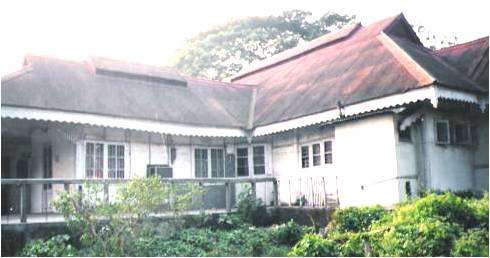
This house is situated in Guwahati, Assam, India
INTRODUCTION
- Type of the house
- Assam type house
- In Assam, British started their kingdom in 1826.
- During 120 yrs of their role in Assam they had constructed many buildings, bridges, bungalow, school and colleges etc.
BRITISH COLONIAL ARCHITECTURE
- Before the British the building constructed by kings were very uneconomical and the construction system were very difficult.
- It is not possible for common peoples.
- The house of the common people were of thatch roof with bamboo walls plastered with a mixture of mud and cow dung.
- The British were studied the local environment and local building materials and accordingly designed comfortable and beautiful buildings.
- They had started a special type of construction, which finally become the typical building type and called” assam type house”.
TOPOGRAPHY
- LATITUDE – 26.25 dg.N
- LONGITUDE – 91.8dg.E
- Topographically, the state can be divided into three parts, viz. the Brahamputra valley, the Barak valley and the Karbi Anglong range.
- Assam falls in a zone prone to earth quake.
- Though mild shaking are familiar to the region, high-intensity earthquakes are rather infrequent.
CLIMATE
- In Assam, pleasant sub-alpine climate prevails in the hills.
- However, the plains experience tropical climate during the rainy seasons.
- Winter starts from around the end of the month of October and lasts till the mid of march.
- The temperature drops to a minimum of 6 to 8 o Celsius, the nights and early mornings are foggy.
- Summer arrives in the middle of May accompanied by high humidity and rainfall.
- The temperature reaches a maximum of 35 to 38 o Celsius.
- However The frequent rains push the mercury level down.
- The Monsoons blow full blast during the month of April and is known as Bordoichilla
BUILDING TYPE
- The building is of two storied house.
- Building is symetrical on both side.
- 1st floor is connected with a timber stair case.
- Open spaces in front (chotal) and back side (bari) of the house.
BUILDING MATERIAL
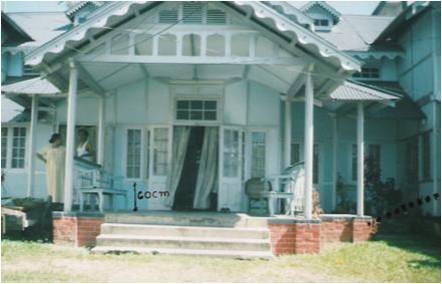
The plinth is made of one brick thick brick wall.
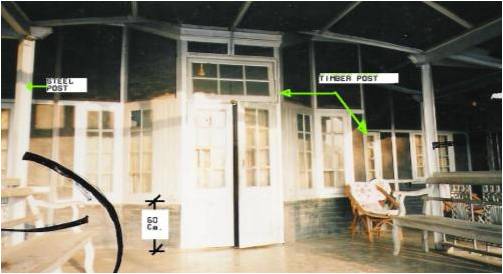
From finished floor level the walls are of half brick thick brick walls up to a ht. 60 cm.
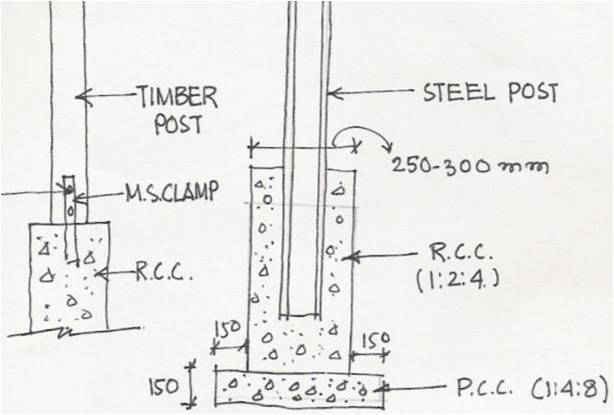
Fixing of steel pillars with nuts and bolts.
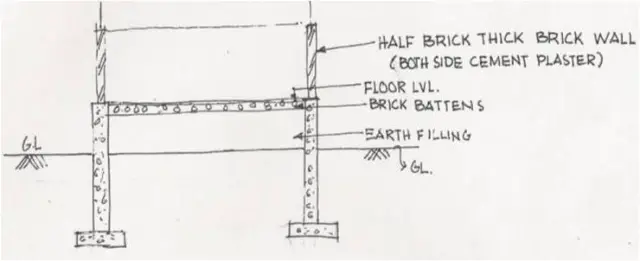
Section of the Plinth
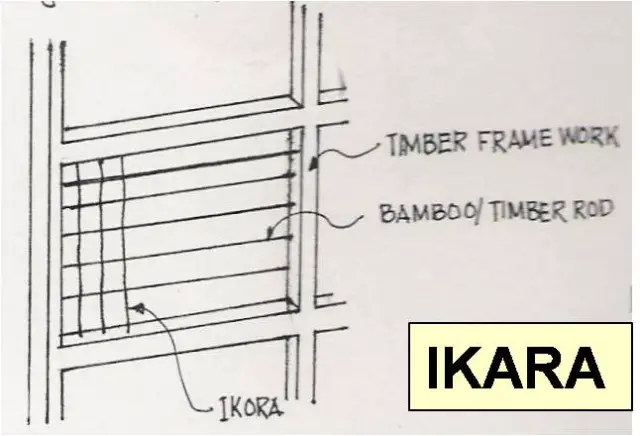
- Walls are of timber frame work, inside those panels ikara used to fill.
- These ikaras are cut in size of the panel and laid vertically.
- The horizontal members usually bamboo.
- After putting the ikara it is left to dry for few days.
- Then it is plastered in both side with mud mortar.
- 3 layers of plaster are done alternatively after dying of each coat.
- Finished coat is of liquid mix of mud and cow dung.
ROOF
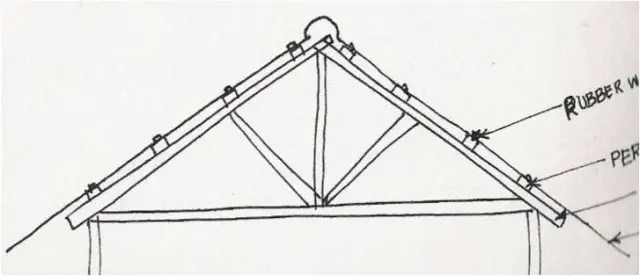
- Roof layout is very critical.
- It is in various level and multi-cornered.
- But the angle of inclination is same.
- Roof is of corrugated iron sheet.
- Sheets are fixed in timber purlin by nail.
- Rubber washer is used to protect the rain drop penetration through the side of the nail.
SPECIAL FEATURES
- Front facade
- as the site is compact with so many houses, so as to provide better ventilation, front façade is very important.
- Contains large no of openings.
- Sheds are provided, restrict rain fall.
- Arrange in different level.
- Better ventilation in front rooms.
- Sill level of the window is about 60 cm only
- Roof is of sloping from to provide shed durng rain
- as the site is compact with so many houses, so as to provide better ventilation, front façade is very important.
- High plinth level
- plinth is of about 60-70 cm.
- To provide foundation.
- Reduce dust and smoke of roads to enter inside the house.
- To provide better air circulation for light inside.
- plinth is of about 60-70 cm.
- Entrance
- Two entrances.
- Directly open to the street.
- Ideally built according to their needs.
- 10 mts of open space infront of the house.
- Ceiling
- Made of wooden beams.
- Wooden members are stick very close to each other.
- Supported by vertical wooden /steel column.
- A fully wooden structure.
- Flooring
- Flooring is of cement flooring.
- Accommodation of dust coming from the street in all rooms in the front side.
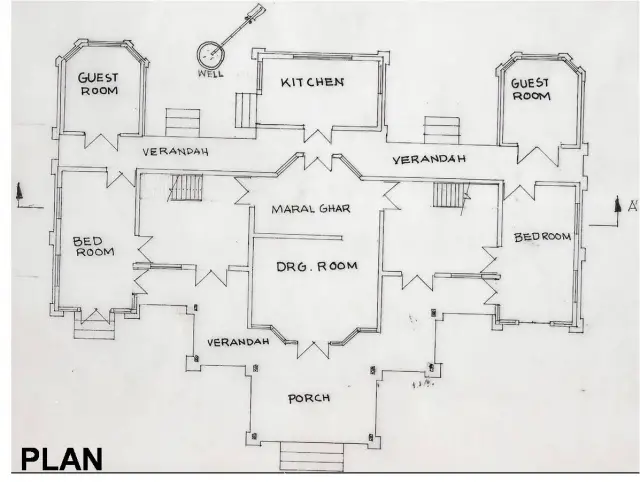
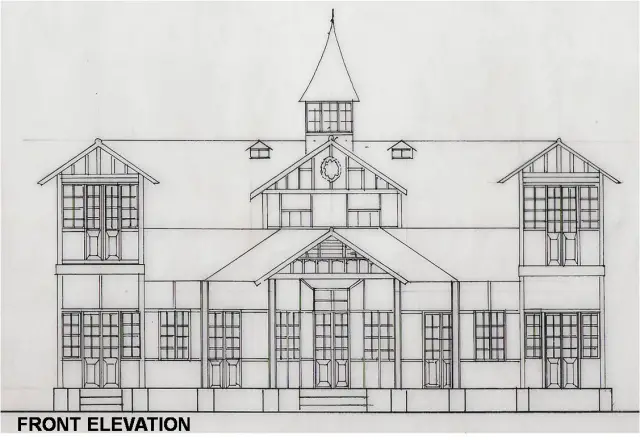

g8 work bro….
g8 work bro….
Very good and detailed
Very good and detailed information, thanks for sharing.
This is wonderful
This is wonderful information. needed this for a project ..
thnx for posting
Very nice. Wish u all more
Very nice. Wish u all more success in future.
very usefull information.
very usefull information.
this is not full information
this is not full information regarding Assam type house, this type of house is called ” ikra house ” and the best part of it is that ikra is earthquake resistance housing system….. in ikra the light weight and ductile material bamboo is used so that it improves its capability to resist earthquakes…..
Nice,go,keep it up.
Nice,go,keep it up.
Superb dude keep it up!
Superb dude keep it up!
very well summarized.
very well summarized.